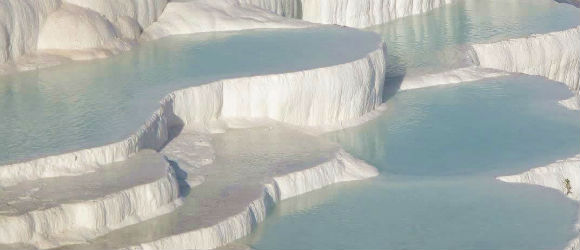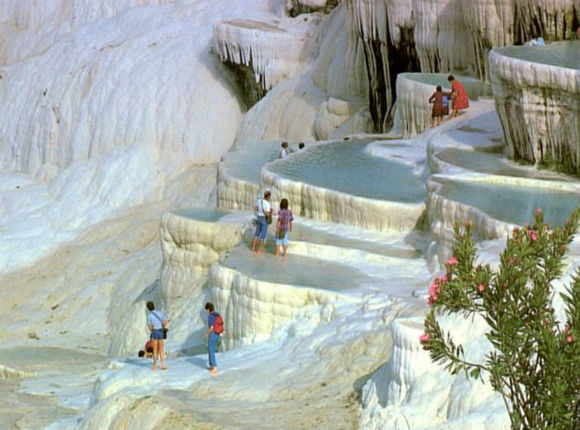Pamukkale village has some charming hotels and pensions, and despite the constant coach parties it’s a good place to get a taste of village life, if you steer clear of the main road. Several other attractions are within easy reach, including Afrodisias, one of Turkey’s most complete and absorbing archaeological sites, and Laodicea, one of the biblical Seven Churches of Asia.
Long before Unesco, the Romans recognised the appeal of the site and built a large spa city, Hierapolis, to take advantage of the water’s curative powers. The tourist boom of the 1980s and 1990s had a detrimental effect on the site, as a line of hotels above the travertines drained away the waters, leaving the travertines dry, dull and dirtied. In a drastic attempt to preserve the site, all the hotels have been demolished and visitors can no longer bathe in the pools; however, the flow of water is still very slow, and it may be that the real culprits are the many swimming pools in the village below.
Calcium’s not just good for bones. If the many habitués of the spa town of Pamukkale are to be believed, it works wonders on muscles and sinews too. ‘Cotton Castle’, 19km north of Denizli, has built a centuries-long reputation on the restorative qualities of its calcium-rich waters. The unique formations of travertine (calcium carbonate) shelves, pools and stalactites, which hug the ridge above town like a white scar, were created by the area’s warm mineral water, which cools as it cascades over the cliff edge and deposits its calcium. It’s a strange piece of landscape unlike anything else you’ll see in Turkey, and it now appears on the Unesco World Heritage list.
Pamukkale,




I visited Pamukkale in 1993 when you were permitted to bathe in the pools. I was staying in Marmaris at the time and I took a two day excursion to Ephesus and Pamukkale. IT was well worth the time and effort to go there. What an amazing place. They said at the time that the pools had powers to halt…
Worth the trouble in traveling out there. Pamukkale is in the middle of nowhere, but the thermal ponds are amazing beautiful.
Apparently you have to go at the right time, because sometimes they shut down some of the thermal springs. We were lucky to see it in its full glory. My wife was gob-smacked. Nothing prepares you for the natural wonder and beauty of this amazing site.
We drove back from Dubai to UK and were looking forward to our visit. Unfortunately it was dried up and closed indefinitely because of damage by too many visitors. Don't know if we'll ever get back there again.
This natural thermal baths is a unique all over the world. The view there with the white soil filled of warm natural water is amazing and no picture can give you the real feeling there. It was a full day trip from Bodrum just to stay two hours in Pamukallle, but worth visiting.
Pamukkale means 'cotton castle' in Turkish. The ancient city of Hierapolis & Cotton Castle, was declared a UNESCO World Heritage Site in 1988.
Hierapolis is a ruin of an ancient city built on top of the mountain. You will have to walk through the ruins to reach Cotton Castle. It is a long walk to the visitor centre (more like…
it was amazing Delph blue lilly pads down a gentle hill filled with warm and very nice water. Watch when you paddle though as it can be slippy.
These pools of warm water form terraces that as you approach from the road below look like snow. But it's warm water and minerals. The signs do say no bathing but I got my feet wet while exploring. It was worth taking a "dip" in the adjacent pool for a small fee. Very relaxing after exploring the ruins of Hieropolis…
The trip from Kusadasi takes a quite a while and once you arrive the hike up the hills to the source of the springs is quite long as well, but ultimately the springs are worth a visit and are worth the trek as well.
beautiful stunning views, with lovely thermal pools to wade in and take great photos. worth the long journey even for a day trip. We arrived from selcuk 3 hours by tour each way. Worth the visit.